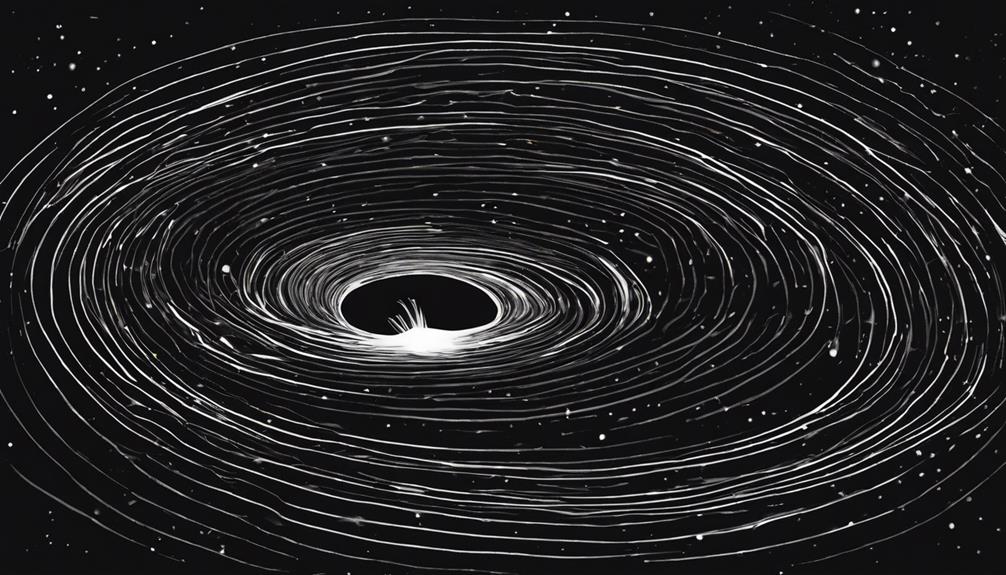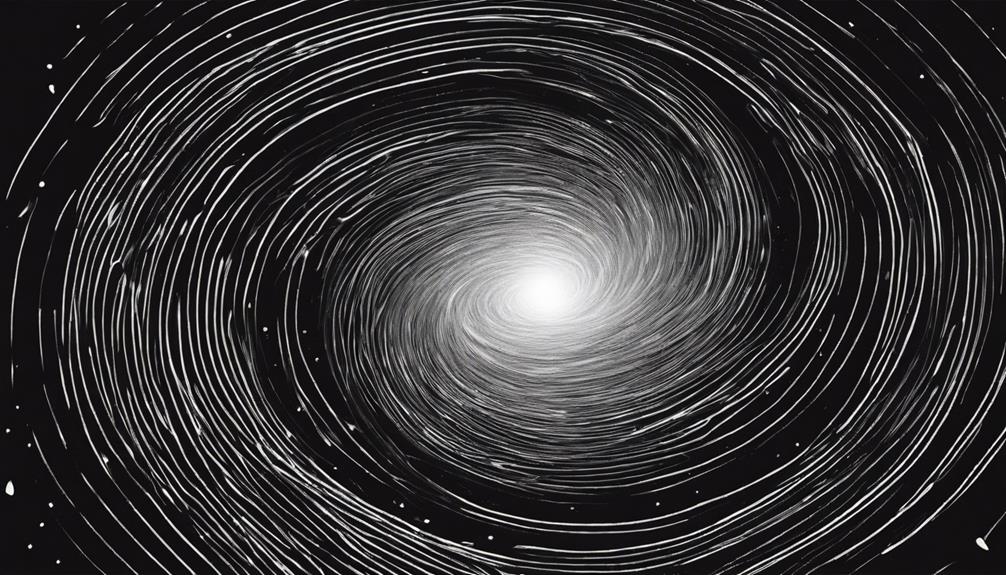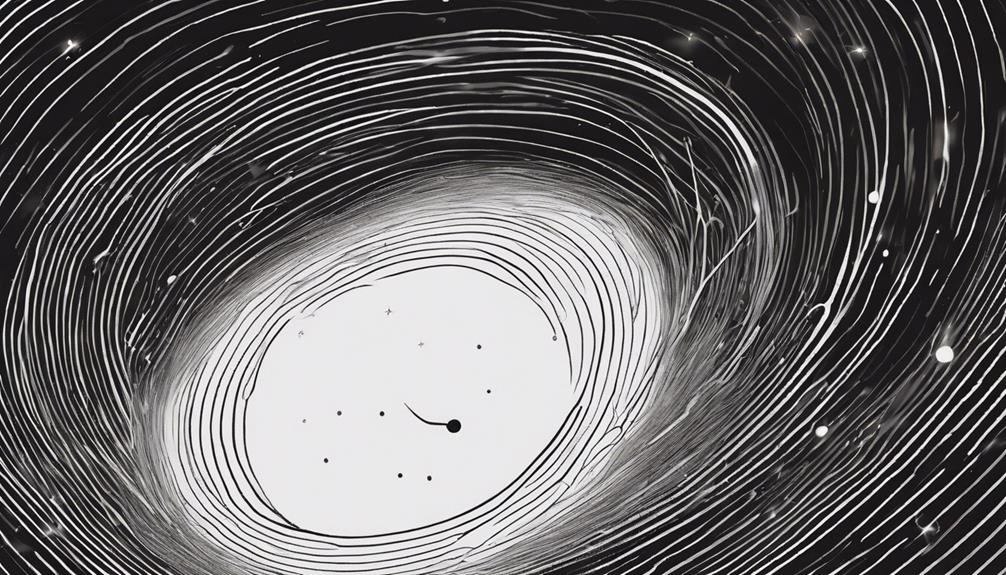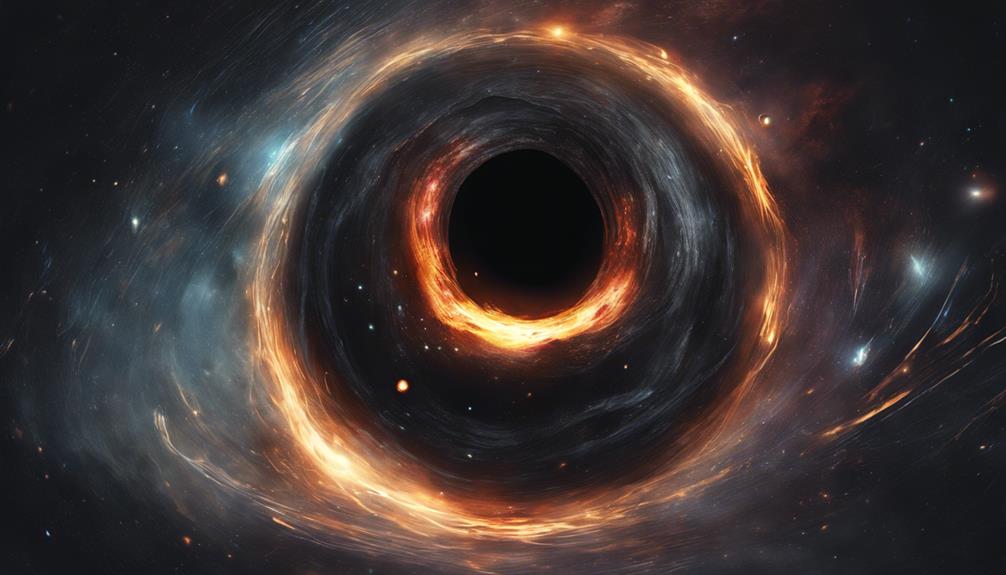Black holes, enigmatic entities in the vast expanse of the universe, captivate scientists and enthusiasts alike with their gravitational prowess. As we delve into the complexities of black holes, we uncover a trove of information that sheds light on the very fabric of space-time. These celestial behemoths challenge conventional wisdom and beckon us to explore the limits of our understanding. Through meticulous observation and analysis, we unravel the mysteries they guard, offering glimpses into the fundamental nature of our cosmos.
Key Takeaways
- Black holes are enigmatic entities formed from collapsing massive stars, distorting spacetime with extreme gravity.
- Observations of black holes provide insights into celestial objects, revolutionizing astronomy and testing scientific theories.
- Gravitational effects near event horizons challenge conventional physics, revealing space-time distortions and matter interactions.
- Black holes play crucial roles in galaxy evolution, stellar dynamics, and the development of new astrophysical models.
Definition of Black Holes

Black holes, characterized by their immense gravitational pull from which not even light can escape, are enigmatic astronomical phenomena formed at the conclusion of certain stars' life cycles. These cosmic entities result from the gravitational collapse of massive stars, leading to the formation of a singularity—a point of infinite density and zero volume. The mass of a black hole can range from a few times that of our Sun to millions of solar masses, exerting an overwhelming gravitational force that distorts spacetime.
At the heart of a black hole lies the singularity, where the laws of physics, as we currently understand them, break down. Surrounding the singularity is the event horizon, a boundary beyond which nothing, not even light, can escape the immense gravitational pull. This defining feature has been studied in recent years with the aid of groundbreaking projects like the Event Horizon Telescope, offering insights into the nature of these cosmic enigmas. Understanding black holes involves grappling with the extreme effects of gravity and the mysterious properties that shroud these celestial bodies.
Appearance of Black Holes
The study of the appearance of black holes delves into the intricate interplay between their gravitational effects and the surrounding spacetime, offering crucial insights into these invisible cosmic entities. One of the most remarkable events in the field of astrophysics was the first image ever captured of a black hole. This groundbreaking achievement provided a visual representation of the silhouette of the supermassive black hole at the center of the Milky Way galaxy, known as Sagittarius A*. This image of a black hole not only confirmed their existence but also showcased the immense gravitational pull that distorts light around them.
To further understand the appearance of black holes, it is essential to explore the different types of black holes, including stellar black holes, supermassive black holes, and intermediate black holes. Each type exhibits unique characteristics that influence how they appear to observers. The visualization of black holes plays a vital role in unraveling the mysteries of these enigmatic cosmic phenomena.
| Types of Black Holes | Description |
|---|---|
| Stellar | Formed from collapsing massive stars. |
| Supermassive | Found at the centers of galaxies and can have masses millions to billions times that of the sun. |
| Intermediate | Have masses between stellar and supermassive black holes. |
Interior of Black Holes

Within the depths of a black hole lies a singularity, an infinitesimally dense point where all mass is concentrated. Surrounding the singularity are the event horizons, with the outer event horizon marking the point of no return for objects falling into the black hole and the inner event horizon being the boundary inside which nothing can escape. The extreme gravity near the singularity exerts unparalleled forces, capable of tearing apart anything that ventures too close, even stars. Matter spiraling into a black hole can give rise to powerful jets of material expelled near the singularity. At the event horizon, quantum effects come into play, creating a barrier-like phenomenon known as the "firewall" that influences the behavior of particles and energy at this boundary. The interior of a black hole presents a realm where the laws of physics, as we currently understand them, are pushed to their limits, revealing the mysterious and awe-inspiring nature of these cosmic entities.
Formation of Black Holes
Formation of black holes occurs through the collapse of massive stars at the culmination of their life cycles, a process driven by the overwhelming gravitational forces within the core. This catastrophic event leads to the creation of one of the most intriguing entities in the cosmos. Here are four key points to understand the formation of black holes:
- Collapse of Massive Stars: When massive stars exhaust their nuclear fuel, the core can no longer sustain outward pressure, causing it to collapse under its gravity.
- Gravitational Pull: The intense gravitational pull generated by the collapsing star is so strong that it traps all material within a confined space, forming a singularity where the laws of physics, as we know them, cease to apply.
- Merging Black Holes: Black holes can also form from the merger of smaller black holes, combining their mass and gravitational influence.
- Accumulation of Matter: Additionally, black holes can grow by accumulating matter from their surroundings, increasing their mass and gravitational pull over time.
Supermassive Black Holes

Supermassive black holes, characterized by masses equivalent to billions of suns, represent enigmatic entities with profound gravitational influence within galaxies. In the Milky Way galaxy, Sagittarius A* is the supermassive black hole situated at the galactic center. These massive celestial bodies are distinct from the black holes formed from the collapse of massive stars, as well as theoretical miniature black holes that may have emerged after the Big Bang. The detection of gravitational waves from the merger of black holes has provided significant evidence supporting the existence of supermassive black holes. However, the presence of intermediate-mass black holes remains a topic of debate among scientists. These colossal black holes grow in size by accreting gas and dust, a process that leads to the phenomenon known as spaghettification for objects passing the event horizon.
| Supermassive Black Holes | Milky Way Galaxy | Gravitational Waves |
|---|---|---|
| Sagittarius A* | Central region | Evidence supported |
Diet of Black Holes
The consumption habits of black holes, encompassing the ingestion of gas, dust, and occasionally entire stars, play a pivotal role in shaping their evolutionary trajectory and the energetic processes they exhibit. When delving into the diet of black holes, several key aspects come to light:
- Matter Accretion: Black holes consume matter through a process known as accretion, where surrounding material is drawn towards the black hole by its immense gravitational pull.
- Feeding Process: The feeding process of black holes involves the gradual accumulation of material, leading to the formation of an accretion disk around the black hole.
- Energy Release: As matter falls into the black hole and spirals inwards within the accretion disk, a significant amount of energy is released in the form of radiation and high-speed jets of particles.
- Tidal Disruption: Black holes can also exhibit tidal disruption, where the immense gravitational forces tear apart celestial bodies like stars, allowing the black hole to consume the resulting debris.
Understanding the diet of black holes is crucial in unraveling their growth, behavior, and the profound impact they have on their surrounding environment.
Discovery of Black Holes

The discovery of black holes has been a monumental achievement in the field of astronomy, reshaping our understanding of the universe. Early observations, such as the detection of Cygnus X-1 in 1971, marked the beginning of a new era in astrophysics. These findings have had a profound impact on the study of celestial objects and the laws governing our cosmos.
Early Observations
Early observations leading to the discovery of black holes shed light on the mysterious nature of these enigmatic cosmic entities.
- First Picture: The first direct image of a black hole was captured by the Event Horizon Telescope in 2019, providing visual evidence of these gravitational behemoths.
- Stellar-Mass Black Holes: Cygnus X-1, identified as a candidate in the 1960s, was the first stellar-mass black hole discovered in a binary system.
- General Theory of Relativity: Albert Einstein's general theory of relativity, formulated in 1915, predicted the existence of black holes as regions of spacetime with extreme gravitational effects.
- Laser Interferometer Gravitational-Wave Observatory (LIGO): LIGO's detection of gravitational waves in 2015 further confirmed the presence of black holes, providing a new way to observe these cosmic phenomena.
Impact on Astronomy
Having transformed our comprehension of celestial bodies, the discovery of black holes has significantly impacted the field of astronomy. Cygnus X-1, the first confirmed black hole, revolutionized our understanding of celestial objects. Observing stars orbiting invisible points in space helped identify black holes, crucial in studying gravitational effects near these entities. Stellar black holes, resulting from massive star collapses, represent one of the various types of black holes discovered. Predicted by Einstein's equations, black holes sparked a new era in astronomy and astrophysics, reshaping our understanding of the universe. This discovery not only sheds light on the gravitational forces at play within our Milky Way galaxy but also opens avenues for further exploration and research in the field of astronomy.
Insights From Black Holes
Black holes offer a unique window into the extreme distortions of gravity and the dynamics of event horizons, making them invaluable for studying the most powerful forces in the universe. By observing how matter behaves near these cosmic entities, scientists can gain crucial insights into the fundamental laws governing the behavior of matter under extreme conditions. These observations not only challenge our current understanding of the universe but also provide a platform to test and refine scientific theories, particularly in the realms of gravity and astrophysical phenomena.
Gravity's Distorting Effects
The gravitational effects observed near black holes provide crucial insights into the profound distortions of spacetime caused by extreme gravitational forces. Here are four key points to understand the impact of gravity near black holes:
- Intense Gravity: Objects near black holes exhibit extreme gravitational forces, causing significant distortions in their surrounding spacetime.
- Stretching of Stellar Objects: Stellar objects approaching black holes experience immense stretching towards the singularity, highlighting the overpowering nature of gravity.
- Quantum Effects at Event Horizon: Quantum effects near the event horizon create a formidable barrier, challenging conventional physics theories.
- Destructive Power: The immense gravitational pull of black holes can tear apart stars that venture too close, showcasing the destructive capabilities of these cosmic entities.
Event Horizon Dynamics
Insights into the dynamics surrounding the event horizon of black holes offer invaluable scientific understanding of gravitational interactions at the extreme limits of spacetime. The event horizon, the point of no return around a black hole, showcases the extreme gravitational forces that cause spaghettification as objects approach it. Moreover, the event horizon provides a window into the nature of space-time curvature and the gravitational effects near black holes. By observing matter and energy falling towards the event horizon, scientists can decipher the dynamics of these phenomena. This study is essential for testing the validity of theories like general relativity in the presence of extreme gravitational fields.
| Event Horizon Dynamics | |
|---|---|
| Extreme Gravitational Forces | Space-Time Curvature |
| Gravitational Effects | Matter and Energy Falling |
First Black Hole Image

Capturing the first image of a black hole marked a significant milestone in astrophysical research, offering a visual representation of a long-theorized but previously unseen cosmic phenomenon. The image was made possible by the collaborative effort of the Event Horizon Telescope (EHT) in 2019, revealing the black hole situated at the heart of the galaxy M87, located approximately 55 million light-years away. This groundbreaking image showcased the presence of a bright ring surrounding the black hole, known as the photon ring, which is a defining feature predicted by theoretical models. The visual evidence provided by the image not only confirmed the existence of black holes but also allowed scientists to delve deeper into the extreme physics governing these enigmatic cosmic entities. By studying this historic image, researchers gain valuable insights into the behavior and properties of black holes, shedding light on the mysteries of the universe.
Key Points:
- EHT captured the first image of a black hole.
- The black hole is in M87, 55 million light-years away.
- The image revealed the photon ring surrounding the black hole.
- The image confirmed theoretical predictions about black holes.
Unanswered Questions About Black Holes
As we contemplate the remarkable image of a black hole unveiled by the Event Horizon Telescope, a myriad of unanswered questions emerge, propelling us into the enigmatic realm of the mysteries surrounding these cosmic entities. Among these mysteries are the fate of information within black holes, the feeding habits that sustain their massive structures, the mechanisms governing their creation, the intricacies of their interior structure, and the enigmatic nature of small black holes.
| Unanswered Questions About Black Holes | |
|---|---|
| Information Loss | Feeding Habits |
| Creation Mechanisms | Interior Structure |
| Small Black Holes |
The fate of information inside black holes raises uncertainties about information loss or potential new universes. Questions persist about the feeding habits, creation mechanisms, and interior structure of black holes. Debate surrounds whether information falling into black holes is truly erased from the universe, posing profound questions in physics. Mysteries exist about small black holes, challenging our understanding of their mass and size.
Scientific Significance of Black Holes

Black holes serve as windows into the extreme realms of physics, shedding light on the fundamental laws governing our universe. Through the study of black hole interactions and their gravitational impact, scientists can map out the intricate web of cosmic influences shaping the cosmos. By unraveling the mysteries of black holes, researchers enhance our understanding of the universe's dynamics and push the boundaries of theoretical physics.
Cosmic Mysteries Unraveled
Challenging conventional notions of physics and expanding the horizons of our understanding of the cosmos, black holes stand as enigmatic entities that hold profound scientific significance in unraveling cosmic mysteries.
- Black holes provide valuable insights into the workings of gravity, shedding light on its effects on massive objects and the curvature of space-time.
- Studying black holes aids in unraveling the mysteries of space and time, offering a glimpse into the extreme conditions where our current understanding of physics is tested.
- The exploration of black holes contributes significantly to the field of astrophysics, advancing our knowledge of the universe's most enigmatic phenomena.
- Understanding black holes is paramount in comprehending the evolution of galaxies, stars, and the overall structure of the cosmos.
Gravitational Influence Mapped
How can the gravitational influence of black holes be precisely mapped to unravel cosmic mysteries and test theories of gravity and space-time? By observing the movement of stars and galaxies around black holes, scientists can map out their gravitational effects. This mapping provides crucial insights into the structure and evolution of galaxies, as the gravitational pull of black holes shapes the movement of stars and influences the dynamics of galactic structures. Black holes play a significant role in understanding the distribution of matter in the universe through their gravitational interactions. By mapping the gravitational influence of black holes, researchers can unravel cosmic phenomena and test theories of gravity and space-time.
| Aspects | Details |
|---|---|
| Observation Method | Movement of stars and galaxies around black holes |
| Insights Provided | Understanding galaxy structure and evolution, influence on stellar motion |
| Role in Universe | Shaping galactic dynamics, influencing matter distribution |
Role of Black Holes in Astrophysics
The pivotal role that black holes play in astrophysics lies in their profound influence on the structural dynamics and evolutionary trajectory of galaxies. This influence stems primarily from their immense gravitational pull, which shapes the movement of stars and galaxies within their vicinity. Understanding the role of black holes in astrophysics is essential for advancing our knowledge of the universe. Here are four key aspects highlighting the significance of black holes in astrophysics:
- Galactic Evolution: Black holes contribute to the evolution of galaxies by affecting the distribution of matter and the formation of structures within them.
- Stellar Dynamics: The gravitational pull of black holes influences the movement of stars, impacting their orbits and interactions within galaxies.
- Cosmic Phenomena: Research on black holes provides insights into various cosmic phenomena, such as galaxy mergers and the behavior of matter under extreme conditions.
- Theoretical Physics: Studying black holes challenges existing theories and contributes to the development of new models in theoretical physics, expanding our understanding of the universe's fundamental principles.
Impact of Black Holes on Space Exploration

Black holes pose challenges for spacecraft navigation due to their intense gravitational pull, requiring innovative solutions for safe exploration. The discoveries made possible by studying black holes extend beyond imagination, providing valuable insights into the fundamental workings of the universe. Understanding the impact of black holes on space exploration is essential for advancing our knowledge of cosmic phenomena and enhancing our technological capabilities for exploring the unknown.
Spacecraft Navigation Challenges
Navigating spacecraft in close proximity to black holes presents formidable challenges due to the significant gravitational forces distorting trajectories and affecting onboard systems. These challenges include:
- Trajectory Distortion: The intense gravity near black holes can cause spacecraft to deviate from their planned paths, requiring constant adjustments.
- Time Dilation Effects: Gravitational effects near black holes can lead to time dilation, impacting the synchronization of onboard systems and communication.
- Instrument Accuracy: The gravitational pull of black holes can interfere with spacecraft instruments, affecting their accuracy and reliability.
- Precision Calculations: Spacecraft near black holes necessitate meticulous calculations to counteract gravitational influences and ensure mission success.
Understanding and mitigating these challenges are vital for the advancement of safe and effective space exploration missions.
Discoveries Beyond Imagination
Spacecraft operations near black holes demand a profound understanding of gravitational dynamics and precise calculations to navigate the complexities of these cosmic phenomena. Black holes, especially supermassive ones at the centers of galaxies, exert immense gravitational forces that can significantly affect the movement of stars and galaxies. By studying black holes, scientists gain valuable insights into gravity and its impact on cosmic phenomena. Research on black holes not only enhances our understanding of astrophysics but also challenges existing scientific theories. For instance, black hole collisions are instrumental in measuring the universe's expansion rate and testing fundamental concepts like those proposed by Einstein regarding mass, space, and time. These discoveries not only expand our knowledge of the universe but also drive advancements in technology for further exploration and research.
Future Studies on Black Holes
Recent advancements in observational technology have paved the way for a new era of scientific inquiry into the intricacies of black hole phenomena. Future studies on black holes aim to explore the mysteries of black hole mergers and their gravitational wave emissions. Researchers plan to study the feeding habits of black holes to understand how they consume surrounding matter and grow in mass. Investigating the interior structure of black holes is a key focus for future studies to unravel the secrets hidden within the event horizon. Advanced technology will be utilized to observe the behavior of material falling into black holes to study the outcomes and effects of such interactions. Additionally, future studies on black holes will delve into the complex relationships between black holes and their host galaxies to understand their mutual evolution and influence. Exciting prospects lie ahead as scientists delve deeper into the enigmatic nature of black holes, shedding light on these cosmic marvels.
Frequently Asked Questions
What Do Black Holes Tell Us?
Black holes offer profound insights into event horizon mysteries, gravitational lensing effects, time dilation phenomena, matter accretion processes, and the groundbreaking discovery of Hawking radiation. These enigmatic entities provide a unique window into the extreme realms of gravity and spacetime, challenging our understanding of the universe's fundamental principles. By studying black holes, we uncover valuable information about the nature of gravity, matter, and the cosmos, advancing our knowledge of astrophysics and theoretical physics.
What Is the Black Hole Everyone Is Talking About?
The black hole that has captured widespread attention is positioned at the heart of our galaxy, known as Sagittarius A*. This astronomical marvel, boasting a mass equivalent to millions of suns, is enveloped in an event horizon, a boundary beyond which escape is impossible due to its immense gravitational pull. At the core lies a singularity, shrouded in mystery, where the laws of physics cease to apply, leading to phenomena like time dilation and space-time distortion.
What Is a Black Hole Short Answer?
A black hole forms from the collapse of a massive star, creating an intense gravitational pull. It has an event horizon, a boundary beyond which nothing can escape. Within it lies a singularity, a point of infinite density. Observable effects include bending light and time dilation. The singularity theory challenges known physics, emphasizing the extreme nature of gravity. These phenomena contribute to our evolving understanding of the universe and the laws that govern it.
Where Do Black Holes Take You?
Black holes, with their immense gravitational pull, act as enigmatic gateways in space exploration. Approaching an event horizon, time dilation occurs, warping perceptions of time. Theories of wormholes propose intriguing possibilities of where black holes may lead, challenging our understanding of the universe. This journey into the unknown symbolizes the paradoxical nature of exploration—balancing the thrill of discovery with the risks of the uncharted.
Conclusion
In conclusion, black holes serve as cosmic anomalies that challenge our understanding of the universe. Like enigmatic cosmic whirlpools, they draw in matter and light, revealing the immense power of gravity in shaping the fabric of space and time. Through the study of black holes, scientists can unravel profound mysteries of the cosmos and gain insights into the fundamental forces governing our universe, paving the way for new discoveries and advancements in astrophysics.
